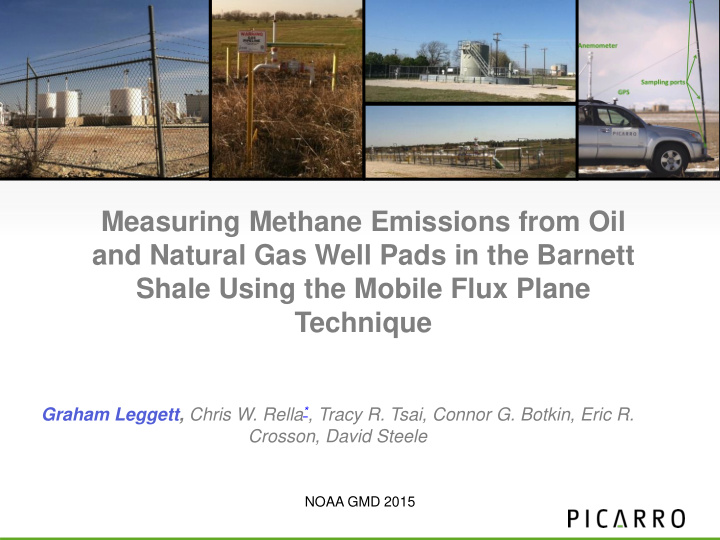



Measuring Methane Emissions from Oil and Natural Gas Well Pads in the Barnett Shale Using the Mobile Flux Plane Technique Graham Leggett, Chris W. Rella * , Tracy R. Tsai, Connor G. Botkin, Eric R. Crosson, David Steele NOAA GMD 2015
Methane Emissions in the Barnett Shale • Natural Gas in the Barnett Shale – ~8% of total US natural gas production (2013) – ~17,500 production well pads (2013) • Barnett Coordinated Campaign (October 2013)
Motivation: Why Measure Well Pad Emissions • There are about 500,000 natural gas wells in the U.S. • Well pads during routine production (i.e., not including drilling and well completion) account for about 2% of total natural gas production [1] • The distribution of emission rates from well pads is a skewed distribution, with a relatively small number of well pads contributing the bulk of the emissions • Our Goal: To develop a simple, rapid, and accurate method for quantifying well pad emissions to identify the largest emitters [1] Howarth, R. W., Santoro, R., & Ingraffea, A. (2011). Methane and the greenhouse-gas footprint of natural gas from shale formations. Climatic Change , 106 (4), 679-690.
Mobile Flux Plane: Create a Virtual Net to “Catch” the Methane wind direction (out of page) AirCores F E 2D sonic anemometer D GPS methane plume 4-6 port Sampler C monitoring inlet B 2Hz CH 4 vehicle path A
Calculating the Emission Rate • The 2D concentration image plus the vertical wind profile is used to calculate the emission rate • No atmospheric transport model or knowledge of emission location is required for the calculation
Controlled Release Validation Experiments with Eben Thoma, USEPA with Eben Thoma, USEPA • Measurements under different atmospheric stability classes (A, B, C, and D) and different surfaces (high grasses, hard-packed earth, low grasses, paved surface)
Integration Methods – Validation Experiments horizontal integral at each height 4-inlets for validation experiments • Plume integrated horizontally (along path of vehicle) • Two methods of vertical plume integration: –Trapezoidal integration –Ground reflected Gaussian plume model with vertical width and center as fit parameters
Validation Experiments Results Emeas / Eact = 1.0 ideal • Trapezoidal integration (TRAP): mean = 0.77; 1-sigma range: 0.40 – 1.47 • Gaussian Plume Fit (GF): mean 1.07; 1-sigma range: 0.56 – 2.04; 2- sigma range: 0.29 – 3.9
Barnett – well pad study methodology • Driving path randomly selected from Barnett region, based on wind direction and proximity of well pads to public roads • Emissions were quantified for all detected plumes (N = 207). Data selection criteria were applied for – wind speed > 1 m/s (N = 200) – plume attributable to a single well pad (N = 177) – distance to well pad < 150 m (N = 150) – centroid of the Gaussian plume fit was below the top inlet (N = 142) – vertical width from the Gaussian plume fit was less than 5 m (N = 115) • 37% of well-pads upwind of the vehicle track and within a nominal distance of about 90 meters of the vehicle had NO detectable emissions
Barnett – Distribution of Emissions • For all leaks with detectable emissions, the arithmetic mean of the distribution is 1.63 kg / hr, – 1-sigma (67%) range of 0.46 – 5.7 kg / hr – 2-sigma range (95%) of 0.13 – 20 kg / hr • The distribution of the emissions is much broader than the measured precision from the validation experiments
Well Pads: Distribution of Emissions • 10% of the total emissions is from the top 0.3% of the sources including 37% of well • 20% of the total pads with no detected emissions is from the top emissions 1.1% of the sources • 50% of the total emissions is from the top 6.6% of the sources • 80% of the total emissions is from the top 22% of the sources • The bottom 50% of the sources contribute less than 2% of the total emissions.
Thank You!
Recommend
More recommend